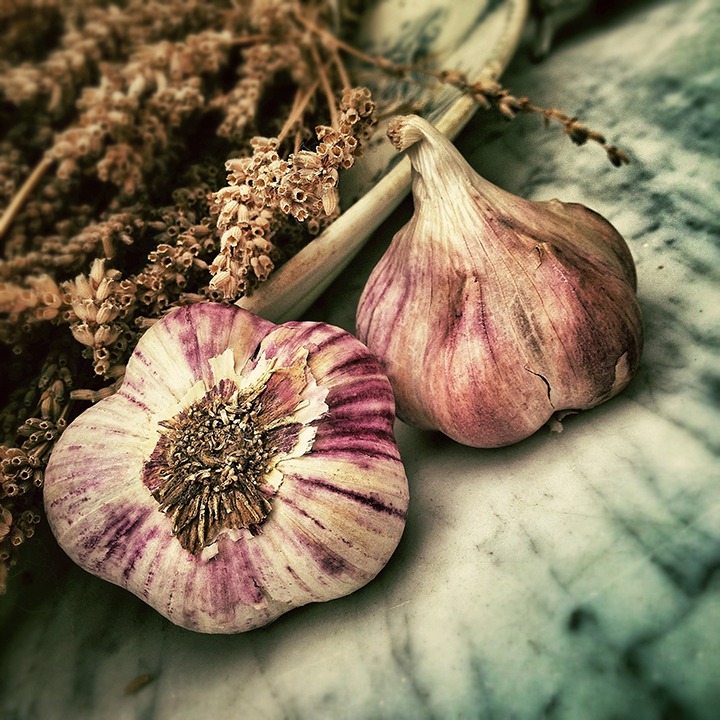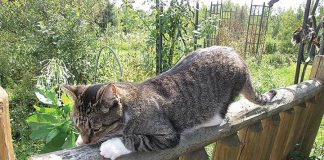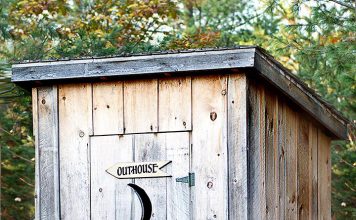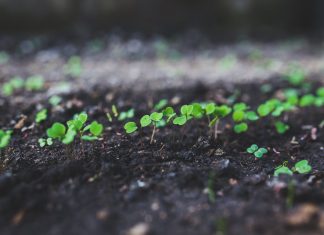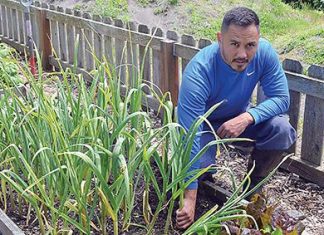| By Linda Gabris |  |
| Issue #86 • March/April, 2004 |
Whether you know it as ail in French, lashun in Hindi, da suan in Chinese, aglio in Italian, fokhagyma in Hungarian or plain old garlic in English, the plant often dubbed “the stinking rose” is as far from being a rose as it is from having bad smell. In fact, to my nose, nothing is more aromatic than a whiff of fresh peeled garlic. And I must admit, should my garden have but room for only one, then a garlic bed instead of rose it’d surely be.
Some folks classify garlic as being a vegetable. Others swear it’s an herb. Then there are those who claim it is a spice, and even some, whom I pity for they don’t know what they’re missing, who know garlic only as a capsule in their medicine cabinet taken on the advice of a doctor for the sake of good health.
|
When viewed from the garden, garlic is indeed a vegetable growing alongside carrots and peas. But once braided and hung, it’s as much a vegetable put up for winter as a bushel of onions or potatoes. Garlic used in age-old herbal concoctions for treating cold or flu, earache, intestinal worms, or other common ailments, in my book is best referred to as an herb. Dehydrated garlic that is crushed into powder gets labeled a spice on my rack, and garlic that’s purchased in capsules at the pharmacy is medical, plain and simple.
As far back as history dates, garlic has been used as food and recognized as having miraculous powers to promote good health and well-being. Garlic was credited with curing a wide range of diseases and reputed as having remarkable power to heal wounds and cleanse the body. Fascinating folklore claims garlic was good for everything from casting love spells to warding off vampires. My grandmother always said that a couple of braids of garlic in the pantry assured fine eating and good health all winter long. I can vouch for the fact that Grandma’s cooking was hard to beat and I seldom saw my grandparents under the weather.
There is evidence that garlic was prized by Egyptians, for old inscriptions note that pyramid builders were allotted garlic rations to ward off evil spirits and disease. The cultivation of garlic (its Latin name is allium sativum) can be traced to ancient Asia and the Mediterranean, and it is believed that garlic was introduced to America in the 1500s. Although garlic was slow to take root in North America, today it is highly respected in domestic and commercial kitchens as well as in medical laboratories where it has gained scientific ground as being a wonder druga leading herb in the study of cancer prevention.
|
Garlic is reputed as being a natural booster to the immune system and I suppose that’s why my grandmother put up an ample stash for winter use to ward off colds and flu. The old adage that “garlic is good for the heart” goes much further than folklore, for evidence has shown that garlic can help lower blood pressure and reduce cholesterol levels. Garlic is also reputed as acting as a blood purifier and having the ability to increase stamina and relieve stress. Aside from being looked at for cardiovascular care, cancer prevention, and natural antibiotic, garlic has been employed to relieve asthma and treat digestive disorders.
Garlic contains iron, zinc, copper, manganese, and calcium as well as vitamins, essential oil, and sulphur compoundswhich it owes its distinctive odor and flavor to. If you’ve been steering clear of this wonderful bulb for fear of it lingering on your breath, then it’s time to free yourself of silly worry for there are many ways to enjoy garlic and still be able to kiss without tell. Try the recipes I’ve included for good eating and good health.
Drying garlic
Whether you grow your own or get a good buy at the farmer’s market, garlic is so easy to dry and so good in soups, stews, and other dishes you’ll wonder how you ever did without.
Dried garlic retains great flavor and yet does not remain heavy on the breath.
Peel as many garlic cloves as you wish to dry and cut each into very thinabout 1/8-inchslices. Lay garlic on cheesecloth covered screens and let dry at room temperature until all moisture is gone. It takes about three days to completely dry. Remove from cloth and put in sealers or paper bag and store in your dry pantry. Dried garlic slices can be added to soups and stews or pounded into powder and used in place of store-bought garlic powder. Dried garlic saves indefinitely. For treating coughs and congestion, grandma steeped dried garlic in apple cider and sweetened it with honey. This strange brew was not all that unpleasant to drink and, as I remember, it seemed to work wonders.
Recipes
Roasted garlic and herbs
This delectable appetizer earns big raves at all my gatherings. Definitely one of the most “in” ways I know to serve garlic. And once roasted, the odor that some folks fret over does not linger.
2 heads of garlic, outer skin removed and tops trimmed to expose heads of cloves
3 Tbsp. virgin olive oil
3 tsp. each of fresh basil and rosemary (or dried herbs)
pinch of salt
fresh grated black pepper to taste
4 Tbsp. finely sliced pitted black olives
1 cup white wine or chicken stock
Parmesan cheese, grated
crusty bread
Heat oven to 350° F. Arrange garlic heads in small casserole dish. Brush with oil and sprinkle with herbs, salt, and pepper. Add olives and wine. Cover and bake for 20 minutes, basting often. Uncover and bake another 10 minutes or until soft. Remove garlic from dish, place on serving platter, pour drippings over top, and sprinkle with Parmesan. Serve with crusty bread. To eat, pull off a clove, pop it out of the “skin” onto bread, and devour. Makes appetizers for 4 to 6. Have fun watching the drippings being sopped up when the garlic is gone.
Garlicky good “presto” pesto sauce
So easy. So quick. This simple delicious sauce makes a satisfying meal when served atop pasta.
3 cups penne, shells or pasta
3 Tbsp. olive oil
8 cloves garlic, peeled and mashed
2 tsp. fresh basil (or 1 teaspoon dried)
seasoned salt, fresh ground pepper to taste
1 Tbsp. finely chopped fresh parsley
Parmesan cheese, grated
Bring six cups of water to a boil. Add pasta and cook to al dente. Heat oil in small saucepan and sauté garlic until soft. Add spices and parsley and stir until flavors are released. Drain pasta and coat with herbed oil mixture. Sprinkle with parmesan before serving. Serves four as supper, six as a side-dish.
Gourmet garlic herb vinegar
This vinegar instills wonderful flavor when used for marinating poultry and fish and adds delightful spark to salad dressings. Use good quality wine vinegar so as not to overpower the garlic and herbs.
1 small onion, finely chopped
6 cloves garlic, peeled and crushed
2 Tbsp. marjoram
1 tsp. each chopped fresh thyme and rosemary
3 black peppercorns
1 tsp. salt
6 cups white wine vinegar
Bring vinegar to boil over high heat. Lower heat and simmer 20 minutes. Remove from stove and allow to cool 10 minutes. Measure remaining ingredients into bowl and pour hot vinegar over top. Cover and let steep in cool place for 10 hours or overnight. Strain the vinegar into clean glass bottle. Store in fridge and use as needed.
Spicy pickled garlic
If I had to pick my pick of pickles, then pickled garlic is the pickle I’d pick. They are so crispy and refreshing and good that sometimes I pair up a couple of cloves with a slice of bread and a wedge of blue cheese and call it gourmet lunch. I’ve even had drop-ins go wild over this simple offering.
Enough garlic, separated into cloves and peeled to fill 3 pint jars. (If garlic is difficult to peel, blanch in boiling water for 20 seconds, then submerge in cold water. This should help loosen skins.)
3-½ cups white vinegar (or more as needed)
1 Tbsp. pickling salt
2 Tbsp. pickling spice
4 Tbsp. sugar
1 tsp. crushed chilies
Boil mason jars and two-piece snap lids in water for five minutes. In a kettle, combine all ingredients, except garlic, and bring to a boil. Simmer 3 minutes. Drain jars and pack with garlic. Cover with boiling brine to within ½ inch of rim. Wipe jar rims with damp cloth and put on lids and secure. Cool, then store under refrigeration until used. Note: If you wish to do up bigger batches for longer term storage, it is advisable to process in pressure canner according to directions in your manual. The recipe above is for garlic that is to be consumed within a month under refrigeration. Don’t worry about these tempting pickles outlasting their shelf life, they won’t. They’ll be gone long before you’ve had your fill.
Garlic herbed butter
A little bit of garlic herb butter goes a very long way for instilling wonderful flavor onto broiled dishes and fresh steamed vegetables. Even a dab on bread can trick a conscientious diner into thinking they’re richly indulging.
1 lb. unsalted butter
3/4cup mashed garlic cloves (peeled cloves from about two or three heads pounded in mortar with pestle)
½ tsp. basil
½ tsp. oregano
3 Tbsp. dried parsley
Let the butter come to room temperature. Add remaining ingredients and blend with hands until evenly mixed. Divide into two balls. Form into logs. Wrap and keep in fridge or freezer until needed. Add a thin slice to any dish that needs a bit of dressing up. Or serve a small slice at the dinner table to accompany bread.


